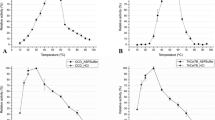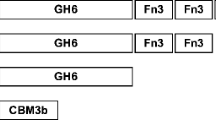Abstract
The DNA fragment encoding the cellulose binding domain of endoglucanase III (CBDEG III) from Trichoderma reesei was subcloned and expressed in E. coli. The CBDEG III had a high affinity for cellulose. The morphological and structural changes of cellulose after treatment with CBDEG III indicated a 17% decrease in number of hydrogen bonds and a 16.5% decrease in crystalline index. X-ray diffraction and IR spectra analyses indicated that the destabilization and breakage of the hydrogen bonds in crystalline cellulose accounted for the non-hydrolytic disruption of the structure of cellulose.
Similar content being viewed by others
References
Gao PJ, Chen GJ, Wang TH, Zhang YS, Liu J (2001) Non-hydrolytic disruption of crystalline structure of cellulose by cellulose domain and linker sequence of CBH I from Penicillium janthinellum. Acta Biochim. Biophys. Sinica 33: 13-18.
Gao P, Liu J, Zhang Y, Qu Y, Pang S (1998) Structural changes in macromolecules of native cellulose during biodegradation. Prog. Nat. Sci. 8: 117-124.
Kim DW, Jang YH, Jeong YK (1997) Adsorption behaviors of two cellobiohydrolases and their core proteins from Trichoderma reesei on Avicel PH 101. Biotechnol. Lett. 19: 893-897.
Kleman-leyer KM, Siika-Aho M, Teeri TT, Kira TK (1996) The cellulose EG I and CBH II of T. reesei act synergistically to solubilize native cotton cellulose but not to decrease its molecular size. Appl. Environ. Microbiol. 62: 2883-2887.
Linder M, Teeri TT (1996) Cellulose binding domain of the major cellobiohydrolase of Trichoderma reesei exhibits true reversibility and a high exchange rate on crystalline cellulose. Proc. Natl. Acad. Sci. USA 93: 12251-12258.
Linder M, Teeri TT (1997) The role and function of cellulose binding domain. J. Biotechnol. 57: 15-28.
Linder M, Salovuori I, Ruohonen L, Teeri TT (1996) Characterization of a double cellulose-binding domain. Synergistic high affinity binding to crystalline cellulose. J. Biol. Chem. 271: 21268-21272.
Mattinen ML, Linder M, Drakenberg T, Annila A (1998) Solution structure of the cellulose-binding domain of endoglucanase I from Trichoderma reesei and its interaction with cello-oligosaccharides. Eur. J. Biochem. 256: 279-286.
Saloheimo M, Lehtovaara P, Penttila M, Teeri TT, Stahlberg J, Johansson G, Pettersson G, Claeyssens M, Tomme P, Knowles JKC (1988) EG III, a new endoglucanase from T. reesei: the characterization of both gene and enzyme. Gene 63: 11-21.
Srisodsuk M, Lehtio J, Linder M, Margolles-Clark E, Reinikainen T, Teeri TT (1997) Trichoderma reesei cellobiohydrolase I with an endoglucanase cellulose binding domain: action on bacterial microcrystalline cellulose. J. Biotechnol. 57: 49-57.
Stahlberg J, Johansson G, Pettersson G (1988) A binding-site-deficient, catalytically active, core protein of endoglucanase III from the culture filtrate of T. reesei. Eur. J. Biochem. 173: 179-183.
Zhang Z, Yao L, Hou Y (1990) Construction and application of a high level expression vector containing PRPL promoter. Chin. J. Virol. 6: 111-116.
Author information
Authors and Affiliations
Corresponding author
Rights and permissions
About this article
Cite this article
Xiao, Z., Gao, P., Qu, Y. et al. Cellulose-binding domain of endoglucanase III from Trichoderma reesei disrupting the structure of cellulose. Biotechnology Letters 23, 711–715 (2001). https://doi.org/10.1023/A:1010325122851
Issue Date:
DOI: https://doi.org/10.1023/A:1010325122851




